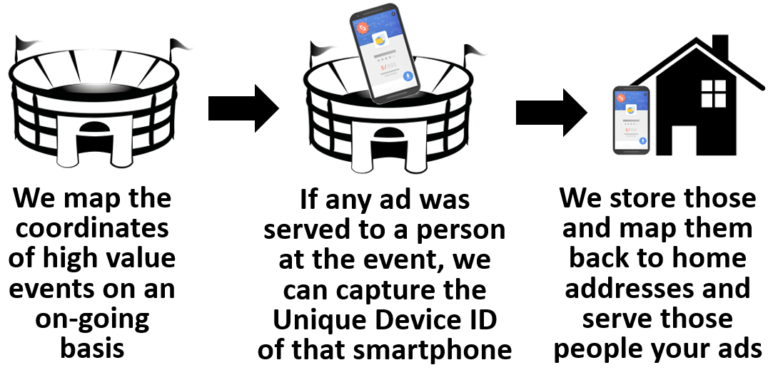By Leslye Schumacher
Geo-Framing technology allow us to go back in time to previous events where we have captured people’s mobile Unique Device ID’s, map those Unique Device ID’s to their homes, and show those people ads now, across all devices. It combines the best of aspects of Geo-Fencing and Household IP Targeting.
How does it work?

If the event you are interested in targeting has already happened, but you still want to target those people, Geo-Framing comes to the rescue! As long as it is an event where Unique Device ID’s have been captured, it can be an event that happened up to 6 months ago! All you have to do is tell us the address where the event took place and the dates. We then let you know how many matches we have, and you can begin targeting those people.
How might a business use this type of technology? Maybe you want to target people who attended a home show, a sporting event, a fair, a concert, a convention – all of which took place months ago – no problem! Or maybe you want to target people who went to a shopping center on Black Friday and show them your ad – no problem!
How can we go back in time to target people from an event that already happened? We go through a four-step process to do Geo-Framing:
Who = Capturing unique device IDs.
Where = Geographical coordinates (latitude & longitude) of that device.
When = A time stamp of when that device ID was captured.
Verify = Once verified and mapped to the household, your ad is shown on all devices – not just the mobile phone!
This is different from the other “geo” products so let’s review:
Geo-Fencing: Drawing a virtual fence around an area or location and showing your ad, to people inside that “fence.”
Geo-Retargeting: Following people AFTER they leave the geo-fenced location and continuing to show them your ads.
Geo-Retargeting Lookalike: Following people AFTER they leave the geo-fenced location and continuing to show them your ads as well as showing their neighbors your ads.
Geo-Framing: To go back in time to previous events where we have captured people’s mobile Unique Device ID’s, map those Unique Device ID’s to their homes, and show those people ads now through the Household IP technology on all devices.
